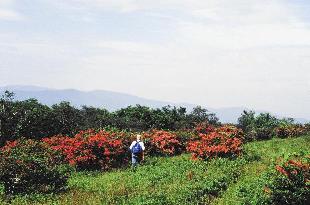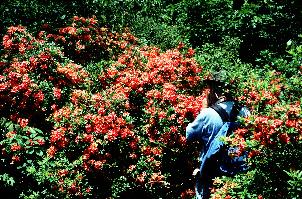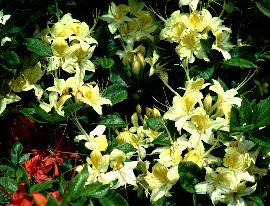 On my first trip, I had a little over an hour to wander among the magnificent plants that are growing on Gregory Bald. We had a late start that day and had to add several miles to our hike because of a closed access road. Shortly after we arrived at the summit, storm clouds started gathering and a passing park ranger cautioned, "You do not want to be up on this mountain when the storm hits." During our hasty retreat that afternoon, I can still remember the vision one of the most awesome sights of nature I have ever seen. As the thunderstorm closed in on the bald, its rolling gray clouds seemed to reach down from the sky like long, curling fingers and grab the ridge. Crackling lightening and rumbles of thunder were all around as we reluctantly rushed down the trail. Holding off rain with a broken umbrella tied together with green dental floss, I was certain that I would become one of those lightening strike statistics. But I reasoned that my life was now complete since I had finally seen the mountain in its glory. Fortunately, on my second trip to Gregory the weather was settled and we were able to spend over four hours strolling among the acres of azaleas after the modest 3 1/2-hour trek to the summit.
On my first trip, I had a little over an hour to wander among the magnificent plants that are growing on Gregory Bald. We had a late start that day and had to add several miles to our hike because of a closed access road. Shortly after we arrived at the summit, storm clouds started gathering and a passing park ranger cautioned, "You do not want to be up on this mountain when the storm hits." During our hasty retreat that afternoon, I can still remember the vision one of the most awesome sights of nature I have ever seen. As the thunderstorm closed in on the bald, its rolling gray clouds seemed to reach down from the sky like long, curling fingers and grab the ridge. Crackling lightening and rumbles of thunder were all around as we reluctantly rushed down the trail. Holding off rain with a broken umbrella tied together with green dental floss, I was certain that I would become one of those lightening strike statistics. But I reasoned that my life was now complete since I had finally seen the mountain in its glory. Fortunately, on my second trip to Gregory the weather was settled and we were able to spend over four hours strolling among the acres of azaleas after the modest 3 1/2-hour trek to the summit.
I am still amazed at the quality and diversity of the hybrid swarm on Gregory Bald. Some of the plants are among the most beautiful hybrids I have ever seen anywhere. In over 30 years of hybridizing, I have produced little that can compare with what is growing naturally on this mountain. The overall landscape beauty of the bald also struck me since it seems to be touched by an artist's hand. At the east end of the bald, just to the right (north) of our initial entry point, there is a magnificent blush-white azalea with dark green foliage that is tucked under a gnarled oak tree. It was as though some skilled landscaper had taken great care to position this very choice plant in a perfect setting to highlight the grand entry to the garden. The large, fragrant flowers of this azalea are brushed with pale pink and have a prominent gold blotch and red stamens, hinting that R. arborescens was a likely parent.
|

Show Stopper Coral Azalea
|
Over the ridge at the west end of the bald near the Parson's Branch entry is another one of the show-stopper azaleas, a large flowered coral hybrid that must be eight feet tall and probably fifteen feet across. Covered in bloom, I once again I remarked that someone had to select this special plant, and then place it at just this strategic spot to let travelers know that they have arrived on Gregory. In the middle of the bald along the path is another one of these show-stopper azaleas, an enormous plant covered with rose pink flowers, each sporting a bright gold blotch.
|
|
Cameras in hand, we roamed from side to side, looking for familiar friends from our previous trip, and discovering new clones that we had not seen before. Trying to decide which were the "best of the best" on the mountain is like judging the most challenging flower show imaginable. There are thousands of entries, and each one is unique and excellent in its own right. Every shade that I have ever seen in a deciduous azalea is up on Gregory. Colors range from white, to pale pink and rose pink, to cherry, deep red, fuchsia, and almost purple. Other color blends run from cream to pale salmon and shrimp pink, to coral, orange, gold, and clearest yellow. Some plants have prominent blotches in yellow or gold, while others are uniform in color. Remembering images of Exbury and Rothschild Supreme azaleas I had admired in catalogs as a child, and I joked with George, "Someone ordered these plants from Wayside Gardens and planted them up on top of this mountain. Look around the base. There must be labels somewhere!"
|

Yellow
|

Pale Pink
|

Gregory Christmas Red
|
We took many rolls of slides and made notes on plants that we felt should be listed as our "top ten" on Gregory, but our list continued to grow. Maybe we could select the best three of each color form instead. One of our favorites included a plant we call "Christmas Red", possibly an excellent form of R. cumberlandense (formerly R. bakeri) with its holiday-festive color scheme of bright red flowers and glossy deep green leaves. It is also one of the larger plants on the bald, and is located on the south side near the edge of the encroaching scrub forest. In that general area is an azalea we call "Goldilocks", a brilliant gold that is brushed with orange, one of the most striking shades imaginable and so heavily flowering that it nearly hides the foliage. Adjacent to Goldilocks is probably the best of the deep pinks with a gold blotch, an azalea I refer to as "Cover Girl" since it was featured on the cover of that Spring 1996 ARS Journal. There are several nice yellows nearby, but as we noticed on our first trip, many of the yellows were a past peak condition. Many of the yellow flowered azaleas seem to bloom ahead of the rest on Gregory, although we found some new selections that were just opening up this time.
|
|
We were also glad we could locate our "Upright Pink", a plant we had noticed on our previous trip. It probably will not make our final top-ten list, but it is very distinctive with small, fragrant pink flowers and unusual, small blue-green leaves. George thought it might be a hybrid of R. arborescens and R. viscosum. A new find for us this year near the east entry will surely rank among our best. It is a pale rose pink with soft yellow blotch and has striking flower buds striped with white. The color is very clear, and the open flowers are paler pink in the center of each petal and a bit darker toward the edge. Near the southwest side of the bald, we discovered a large-flowered fuchsia with gold blotch, and it had gorgeous glossy green foliage. The florets on this clone were almost 2 inches across and the color was incredibly vivid. This clone will probably make my top ten list too.
|
Return to Gregory Bald
Related Links
About the Author
Don Hyatt's General Garden Page
Don Hyatt's Homepage
dhyatt@thor.tjhsst.edu
|